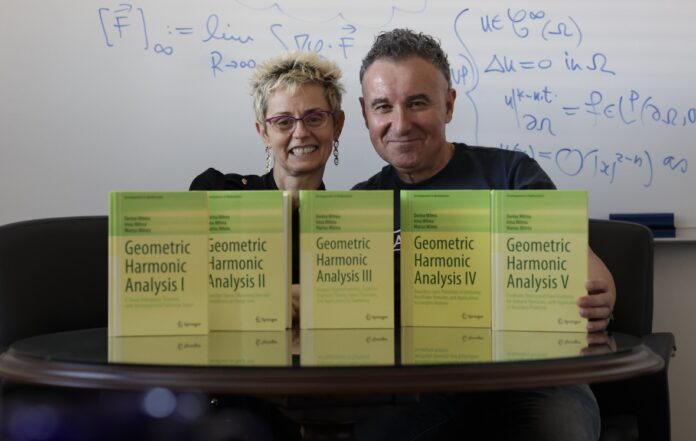
By Caleb Wheeler | Staff Writer
It’s not every day that math is in the news, but Baylor professors have brought it to the spotlight.
The team is comprised of Dr. Marius Mitrea and Dr. Dorina Mitrea — a Baylor mathematician couple — as well as Marius’ sister and Temple University professor Dr. Irina Mitrea. After 15 years of work on groundbreaking research, the trio has finally published the largest volume of mathematics in history.
In fall 2023, the group published Geometric Harmonic Analysis (GHA), a five-volume research monograph in which each volume is 1,000 pages. While 5,000 pages may seem like a lot, Marius Mitrea said they still had to shave off roughly 300 pages for the research to be published.
“Let’s take some sort of rock or some sort of weird-shaped object flying through the sky,” Marius Mitrea said. “Then, [a] wave that hits this now scatters in really mysterious ways, because the geometry of the scatter influences the manner in which it gets scattered.”
Marius Mitrea said that while flat surfaces reflect waves back, jagged edges and corners cause waves to do “exotic and strange” things. The team worked to uncover the reasons for this phenomenon.
“The idea in general is that from whatever bounces back, you are trying to determine the actual shape of the object,” Dorina Mitrea said. “So I suppose that maybe this is something that he has discussed. There are various angles of what we are doing, and this is one particular application, so we just called [it] actually inverse scattering.”
Dorina Mitrea said that originally, people approached these issues with the assumption that everything was smooth. GHA will allow research to look beyond that.
“I’m actually using those volumes to work with my own students, so this is alive and well,” Marius Mitrea said. “It’s not something that, once it’s finished, goes on a shelf and that’s it. This is going to be a document that is going to be very much relevant to us.”
Marius Mitrea said the monograph is so large that Springer is the only mathematics publishing company that could produce the volumes. He said this was a benefit, as Springer is the most prestigious publishing house in mathematics.
“What’s complicated here is that this is a game of aeronautics,” Marius Mitrea said. “It’s not like we can stop midway through the whole thing and say, ‘OK, that’s good enough.’ You either have it to the very last page or nothing comes. As opposed to other things in mathematics, you can never say, ‘I’m done. I solved the problem 80% or 90%.’ It’s a game of all or nothing.”
Because the research is new, it is part of the Developments in Mathematics publication series.
“We work with spaces, with operators, with all geometry,” Dorina Mitrea said. “The geometry itself, being so complicated and sophisticated, forces us to create new theories, new settings to develop and push the boundaries of what it was before.”
Marius Mitrea said one of the most difficult parts of the research was the lack of a “safety net.” However, he said this kind of research is exactly what he loves doing with his students as well.
“I want to change things around here,” Marius Mitrea said. “I want to make an effort to engage our students in really competitive, cutting-edge research. It’s not like if you work on a Ph.D. with me, we’ll try to get you a thesis that’s going to get your diploma. … The main goal if you work with me is we’re going to make a difference.”
Marius Mitrea said this is the type of thing the team was working on when it developed GHA. It found an area of mathematics where the necessary tools were unavailable, and it tried to solve the problem.
“The classical theory was working well, and it was giving useful results, but the moment you start allowing corners, … you have no idea how disruptive that can be,” Marius Mitrea said.
Marius Mitrea said he expects GHA to be a part of the mathematics landscape for the foreseeable future, as there is no expiration date in mathematics.
“Mathematics is different [from other fields],” Marius Mitrea said. “We are more like a pyramid in which every generation brings its own slab of stone and places it on top of everything else that was there before. [GHA] is going to be that proverbial slab of stone.”
Marius Mitrea said he sees GHA working as a lighthouse to guide future research within the field. While working on the project led to lost sleep and late nights, he said he was not complaining because working on something he loved gave him a “rush of adrenaline.”
“We’re very excited about it,” Dorina Mitrea said. “I’ve realized that even though we’ve written books before, and we will continue the mathematics, that this is the magnitude of something that we are proud of. Looking back at it, it’s something that could stay at that — always this nice feeling. Mathematics, as opposed to other sciences, if it’s true today, is going to be true many years from now.”





